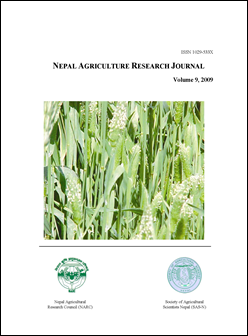Impact of Mulching on Wheat Yield and Weed Floras in the Mid-hills of Nepal
DOI:
https://doi.org/10.3126/narj.v9i0.11638Keywords:
Management, Mulching, Suppression, Weed floras, WheatAbstract
Studies on the effect of mulching and weed management strategies in wheat were initiated at Khumaltar during the winter season of 2000-2002. The treatments were weedy check, handweed alone, post emergence application of sulfosufuron, and NPK application together with or without mulching. Rice straw mulch was applied at the rate of 4 t/ha. Phalaris minor, Alopecuros sp., Chenopodium album, Rumex crispus, Polygonum hydropiper, Stellaria media, Cannabis sativa, and Soliva anthemifolia were the dominant species. Among them, C. album, P. minor and Alopecuros aqualis were the dominant species. The effect of mulching was seen six weeks after wheat planting. The weedy check with mulch suppressed the weeds about fifty percent compared to that of without mulching. Wheat yields together with yield attributing characters were also higher in the treatments with straw mulch.
Nepal Agric. Res. J. Vol. 9, 2009, pp. 21-26
DOI: http://dx.doi.org/10.3126/narj.v9i0.11638
Downloads
Downloads
Published
How to Cite
Issue
Section
License
This license allows reusers to copy and distribute the material in any medium or format in unadapted form only, for noncommercial purposes only, and only so long as attribution is given to the creator.




